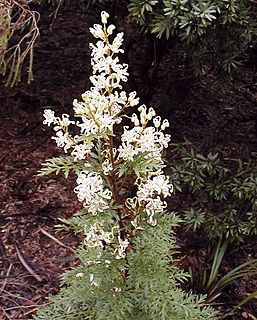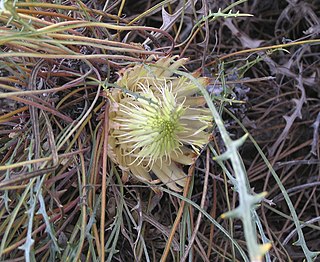Related Research Articles

The curlew sandpiper is a small wader that breeds on the tundra of Arctic Siberia. The genus name is from Ancient Greek kalidris or skalidris, a term used by Aristotle for some grey-coloured waterside birds. The specific ferruginea is from Latin ferrugo, ferruginis, "iron rust" referring to its colour in breeding plumage.

The ruddy shelduck, known in India as the Brahminy duck, is a member of the family Anatidae. It is a distinctive waterfowl, 58 to 70 cm in length with a wingspan of 110 to 135 cm. It has orange-brown body plumage with a paler head, while the tail and the flight feathers in the wings are black, contrasting with the white wing-coverts. It is a migratory bird, wintering in the Indian subcontinent and breeding in southeastern Europe and central Asia, though there are small resident populations in North Africa. It has a loud honking call.

Lomatia is a genus of 12 species of evergreen flowering plants in the protea family Proteaceae. Within the family, they have been placed, alone, in their own subtribe, Lomatiinae according to Johnson & Briggs 1975 classification of the family and subsequently in Flora of Australia (1995).

The Brachyceran infraorder Xylophagomorpha is a small group that consists solely of the family Xylophagidae, which presently contains subfamilies that were sometimes considered to be two small related families. Other obsolete names for members of this family include Exeretonevridae and Heterostomidae.

Banksia rufa is a species of prostrate shrub that is endemic to the south-west of Western Australia. It has broadly linear, pinnatifid or pinnatipartite leaves with between five and twenty lobes on each side, yellow, orange or brownish flowers in heads of forty or more, and glabrous, egg-shaped follicles.

Alex George's taxonomic arrangement of Dryandra was the first modern-day arrangement of that taxon. First published in Nuytsia in 1996, it superseded the arrangement of George Bentham, which had stood for over a hundred years; it would later form the basis for George's 1999 treatment of Dryandra for the Flora of Australia. In accordance with contemporary thinking, George treated Dryandra as a genus, dividing it into three subgenera, the largest of which was divided into 24 series. The arrangement stood until 2007, when Dryandra was transferred into Banksia as B. ser. Dryandra. No alternative has yet been proposed.
Banksia rufa subsp. magna is a subspecies of Banksia rufa. It was known as Dryandra ferruginea subsp. magna until 2007, when Austin Mast and Kevin Thiele sunk all Dryandra into Banksia. Since the name Banksia ferruginea had already been used, Mast and Thiele had to choose a new specific epithet for D. ferruginea and hence for this subspecies of it. As with other members of Banksia ser. Dryandra, it is endemic to the South West Botanical Province of Western Australia.
Banksia rufa subsp. chelomacarpa is a subspecies of Banksia rufa. It was known as Dryandra ferruginea subsp. chelomacarpa until 2007, when Austin Mast and Kevin Thiele sunk all Dryandra into Banksia. Since the name Banksia ferruginea had already been used, Mast and Thiele had to choose a new specific epithet for D. ferruginea and hence for this subspecies of it. As with other members of Banksia ser. Dryandra, it is endemic to the South West Botanical Province of Western Australia.
Banksia rufa subsp. flavescens is a subspecies of Banksia rufa. It was known as Dryandra ferruginea subsp. flavescens until 2007, when Austin Mast and Kevin Thiele sunk all Dryandra into Banksia. Since the name Banksia ferruginea had already been used, Mast and Thiele had to choose a new specific epithet for D. ferruginea and hence for this subspecies of it. As with other members of Banksia ser. Dryandra, it is endemic to the South West Botanical Province of Western Australia.
Banksia rufa subsp. obliquiloba is a subspecies of Banksia rufa. It was known as Dryandra ferruginea subsp. obliquiloba until 2007, when Austin Mast and Kevin Thiele sunk all Dryandra into Banksia. Since the name Banksia ferruginea had already been used, Mast and Thiele had to choose a new specific epithet for D. ferruginea and hence for this subspecies of it. As with other members of Banksia ser. Dryandra, it is endemic to the South West Botanical Province of Western Australia.
Banksia rufa subsp. pumila is a subspecies of Banksia rufa. It was known as Dryandra ferruginea subsp. pumila until 2007, when Austin Mast and Kevin Thiele sunk all Dryandra into Banksia. Since the name Banksia ferruginea had already been used, Mast and Thiele had to choose a new specific epithet for D. ferruginea and hence for this subspecies of it. As with other members of Banksia ser. Dryandra, it is endemic to the South West Botanical Province of Western Australia.
Banksia rufa subsp. tutanningensis is a subspecies of Banksia rufa. It was known as Dryandra ferruginea subsp. tutanningensis until 2007, when Austin Mast and Kevin Thiele sunk all Dryandra into Banksia. Since the name Banksia ferruginea had already been used, Mast and Thiele had to choose a new specific epithet for D. ferruginea and hence for this subspecies of it. As with other members of Banksia ser. Dryandra, it is endemic to the South West Botanical Province of Western Australia.
Banksia rufa subsp. rufa is a subspecies of Banksia rufa. It was known as Dryandra ferruginea subsp. ferruginea until 2007, when Austin Mast and Kevin Thiele sunk all Dryandra into Banksia. Since the name Banksia ferruginea had already been used, Mast and Thiele had to choose a new specific epithet for D. ferruginea and hence for this subspecies of it. As with other members of Banksia ser. Dryandra, it is endemic to the South West Botanical Province of Western Australia. As an autonym, it is defined as encompassing the type material of the species.

Lomatia ferruginea, commonly known as fuinque, is a small evergreen tree in the family Proteaceae.

Patella ferruginea, commonly known as the ribbed Mediterranean limpet, is a species of sea snail, a true limpet, a marine gastropod mollusk in the family Patellidae, one of the families of true limpets. It is a large limpet, native to the western Mediterranean Sea, and although common in the past, it is now rare and restricted to only a few locations.

Darlingia ferruginea, commonly known as the brown silky oak, is a rainforest tree of the family Proteaceae from Northern Queensland.
Helicia ferruginea, commonly named hairy honeysuckle or rusty oak, is a species of rainforest trees, of eastern Australia, from the flowering plant family Proteaceae.

Hakea ferruginea, commonly known as rusty hakea, is shrub in the family Proteacea. It has flat leaves and white to cream-coloured flowers from late winter to mid-summer and is endemic to Western Australia.
Stenoparmena mussardi is a species of beetle in the family Cerambycidae. It was described by Stephan von Breuning in 1971.
Stenoparmena nigra is a species of beetle in the family Cerambycidae. It was described by Stephan von Breuning and Pierre Téocchi in 1983.
References
- ↑ BioLib.cz - Stenoparmena ferruginea. Retrieved on 8 September 2014.
- ↑ https://animaldiversity.org/accounts/Stenoparmena_ferruginea/classification/